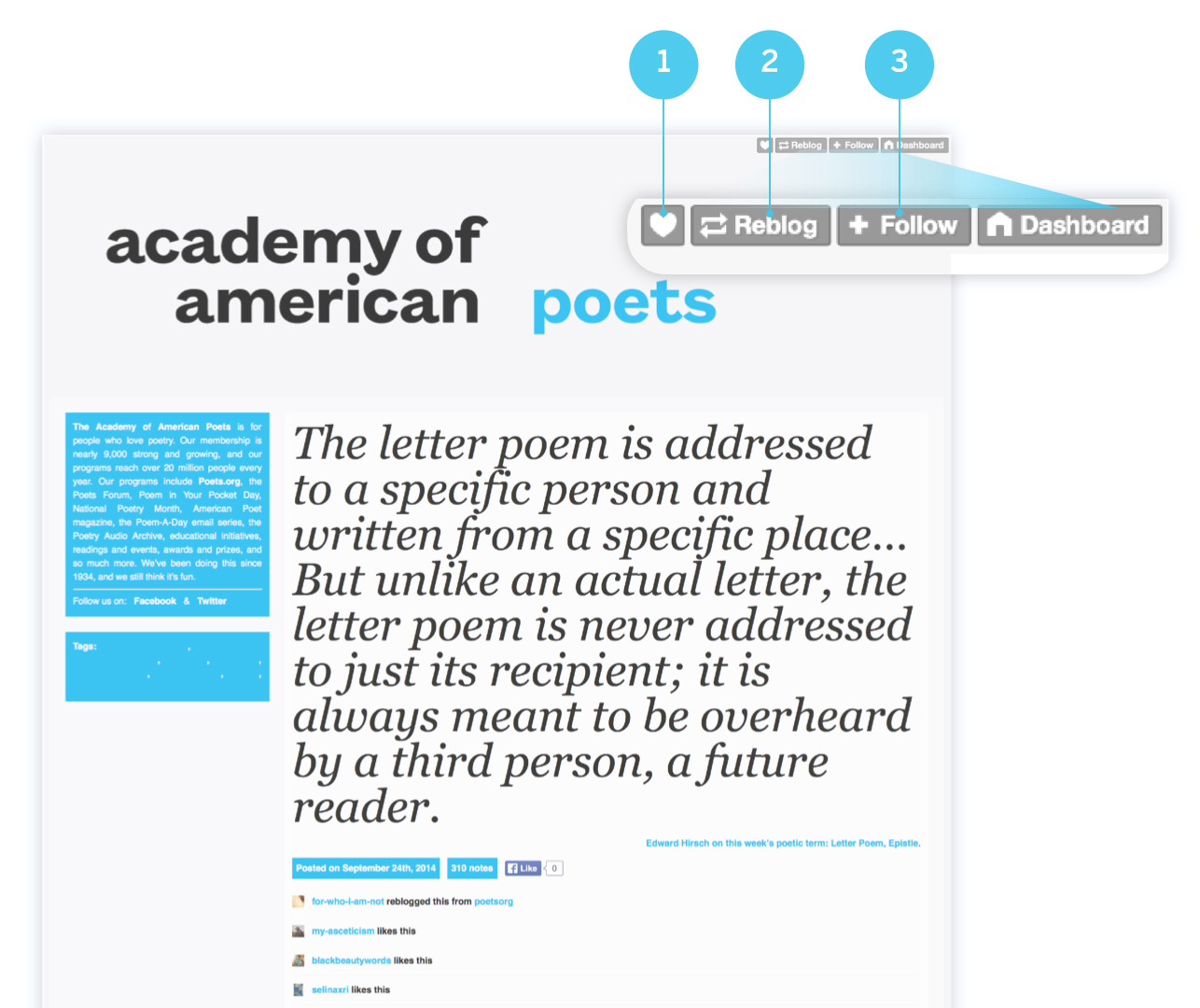A Guide to Tumblr
What does Tumblr do?
Tumblr is a microblogging platform that allows its users to post text, photos, quotes, links, music and videos from a browser, phone, desktop and email. Tumblr combines blogging and social networking in a single platform. It is this dual nature that sets Tumblr apart: in addition to functioning in the traditional blog format, Tumblr also displays content as a stream, much like the news feeds of popular social networks. Users often discover stories through this stream of content.
The site is mainly a mix of bloggers and brands. There are essentially two types of bloggers on Tumblr: those who create original content and those who curate, or re-blog posts. Tumblr is highly customizable and users are able to easily personalize everything, from their blog’s colors to its HTML. This platform leans heavily towards using multimedia and avoids long, text-heavy posts.
Who does Tumblr reach?
Tumblr has 90.8 billion posts and 29.2 million unique visitors across 202.4 million blogs.
- Young. Roughly 46 percent of Tumblr’s users are between the ages of 16 and 24. Tumblr is a platform on which teens and young adults are active and engaged. Sixty-six percent of all visitors on Tumblr are under the age of thirty-five, while thirty-nine percent are under twenty-five years old.
- Urban and educated. Like almost all other social networking services, Tumblr skews toward the urban and educated. Seven percent of Internet users from urban areas use Tumblr, as does the same percentage of online users with college degrees.
- Desktop users. Tumblr has more page views from a computer browser than from a mobile device browser in the United States.
- Gender. Unlike other social media sites, Tumblr users are balanced between genders—51 percent of U.S. Tumblr users are male.
- Ethnicity. Hispanic and African-American users make up 29 percent of Tumblr’s audience. Sixteen percent of Tumblr users are Hispanic—higher than the use by Hispanics on other social networks.
- Countries with highest usage. As of January 2014, the top 5 countries using Tumblr are: the United States, India, the United Kingdom, Brazil and France. Thirty-one percent of all visitors are located in the United States.
What do I need to use Tumblr?
- Technology: Computer/smartphone/tablet, Internet connection
- Suggested Frequency: One to five times per day
What can I share on Tumblr?
You can share text, photos, quotes, links, music, and videos.
How should I use Tumblr?
Tumblr has its own guide with useful tips.
Why should I use Tumblr?
If you are trying to reach teens and young adults with photo-focused blog posts, Tumblr may serve as an ideal platform. Tumblr is also a useful social network for repurposing stories and content by others that align with your mission, cause and interests.
What are the strengths and limitations of Tumblr?
Pros
- Easy to use. Tumblr allows users to publish attractive posts quickly and easily. By allowing users to choose from a list of post templates, Tumblr provides automatic formatting. It is also possible to conveniently post to Tumblr from email or any mobile phone.
- Community based. Tumblr provides an excellent medium to post thank you cards, letters of gratitude, and donor recognition.
- Concise. Tumblr encourages short posts which tend not to be text heavy.
- Complementary. Shorter blog posts can be created that mirror themes of your organization’s traditional blogs, but in a new medium and format. This means your content can fit seamlessly with your existing platforms, while exposing it to new audiences.
- Customizable. Currently, Tumblr offers approximately 1,250 themes to customize your blog’s appearance. Once a theme is chosen, users can further customize their blogs by changing theme colors or adding additional pages.
- Virality. A blog that is informative and high quality has the potential to be reblogged quickly and easily, exposing it to a much broader audience across Tumblr.
- Visual. As a visual-heavy platform, Tumblr is an effective network if you have video or photo-rich content.
- Posting Queue. Tumblr provides users the ability to write posts in batches, save them to a queue and then schedule posting, helping to keep their blog active every day.
- Inbuilt Analytics. Not only does Tumblr have built-in search engine optimization, it also has its own analytical tools for basic performance tracking. Tumblr users also have the option to incorporate Google Analytics into their blogs for free.
- Dashboard. Tumblr users all have a “Dashboard,” which functions like Facebook’s News Feed, showing users real-time updates from the blogs they follow in a list format.
- Evergreen content. Social networks like Twitter require up-to-date and timely content, but evergreen stories do well on Tumblr. This is because Tumblr isn’t news driven and stories that receive attention today could still be popular, even a few years down the road.
- Young. Tumblr is a good network to engage teens and young adults.
- Gender. Most social networks tend to skew towards women, but Tumblr users are equally divided between genders.
- Searchable. Tags work similarly to hashtags and increase the visibility of your content. Themes or storylines can be developed using Tumblr tags.
- Built-in analytics. Many social networks lack built-in tools to track metrics, but Tumblr has a native analytics reporting system for basic metrics, which is free to use.
- Multiple blogs. You can have a primary blog and multiple secondary blogs under one account.
- Group blogging. Multiple authors of separate Tumblr accounts can contribute together to secondary blogs.
Cons
- Urban. Tumblr isn’t as popular with rural populations as it with urban populations.
- Older generations limited. The majority of Tumblr’s user base is under 35 years old.
- Comments. Tumblr does not have a native comment system, and users are required to install third party comment systems such as Disqus to allow comments. The Reply feature serves as an alternative, but only Tumblr users can access it.
- Limited capabilities. Tumblr isn’t as effective for content that is text heavy or lacking images. Those accustomed to conventional blogging tools such as WordPress may find Tumblr limiting at first, especially when trying to publish longer articles.
- RSS Feed. Although a blog, Tumblr has no direct RSS feed.
- Niche audience. Tumblr is more of a niche platform and appeals to a smaller segment of Internet users.
What story formats work best on Tumblr?
Tumblr supports a variety of multimedia formats, but it is mainly a visuals-heavy platform. Currently, photos are the most popular format used, followed by animated GIFs, text and videos.
What’s the most effective way to share stories on Tumblr?
Plan ahead and create an editorial calendar with Tumblr’s built-in scheduling and queuing functionality. You can learn more about these functions here.
How do Tumblr’s users share and engage with content?

- Follow. Tumblr users Follow blogs that they are interested in.
- Like. Users can Like a post if they find it interesting.
- Reblog. Reblogs are more useful for posters than the other main native option for interacting with content on Tumblr—the Like. When users reblog, they share another users’ content on their Tumblr page, exposing the content to their Followers as well as validating the original poster.

- Use the Q&A box. Tumblr’s built-in Q&A feature is used for asking questions and facilitating interactions.
- Use Tags. Tags make it easier for readers to find posts about specific topics. Tumblr users track topics using tags. Without them, your content will be harder to find and even harder to track.
- Reply. Users on this platform can interact with your content by replying to it, which is similar to commenting.
How should I engage users on Tumblr?
- Follow. In addition to posting your own content, follow others to get their attention. Find content to add to your feed and begin networking with others on Tumblr. Following blogs makes their content appear in your News Feed.
- Like. Engage with other stories and blog posts by liking them.
- Reblog. Reblogging stories will help other users notice your content and broaden your network as well.
- Ask and Reply. Tumblr does not provide a comment system like most traditional blogging platforms. Instead, it uses a combination of the “Ask” feature to allow users to interact with each other.
Also, the Reply option can be enabled by the blog author to allow replies from people the author follows and people who have been following the author for at least 10 days. Replies on Tumblr are limited to 250 characters or less.
Instructions on installing Disqus for Tumblr are available here.
How can I increase visibility on Tumblr for my content?
- Be consistent. Like most other social media sites, consistent use and interaction is key on Tumblr.
- Be active. On Tumblr, you can post an abundance of content as long as it’s valuable and/or entertaining. Producing a steady stream of quality content is the best way to keep your audience interested.
- Be strategic about when to post. The best times to post on Tumblr are between 5 p.m. and 1 a.m. EST for maximum chance of engagement.
- Use Tags. Take full advantage of Tumblr’s easy tagging system. The right tags will make your stories visible to users interested in your causes. Tags appear with a hashtag in front of it at the bottom of every post. It only takes a few seconds to create tags and they will increase the likelihood of your content being found.
- Use the “Promote” option. If the Promote option is checked, Tumblr may promote your blog and content on various directory pages.
- Search engine optimization. Allow search engines to index your blog. If this option is checked, your blog will appear in search results on sites such as Google and Yahoo.






Be the first to comment